 Two citizens
of Kappelen, emotion at the Kilimanjaro
Two citizens
of Kappelen, emotion at the Kilimanjaro
Why the heck would you climb the Kilimanjaro
for? That is generally the question one would ask! To wake up
at half way, at 2 am, being short of breath on the verge to bring
up? Is the sight of the summit the real motivation then? If you
are unlucky, the sky will be clouded over but even with clear
weather, it will not be "out of Africa".
Why would one go there then? Well, I have flown several times
over this majestic volcano with its snow-capped peak in the middle
of the African continent. The sight impressed quite much and
I began to dream about climbing this mountain.
Once I was decided to go, I went in search of a tripmate who
would accept to follow me in the adventure. I found it, asking
Bernard Lambert who later turned out to be the ideal partner.
The Kilimanjaro is the largest volcano on the planet.
It has quite impressive dimensions: 80 km at the foot and about
6000m (19,340 feet) high, it can be seen from hundreds of kilometres
around.
It contains 4 ecological zones:
| 1800-2800 m | rain forest | Climate : damp and warm | 22° C to 28° C |
| 2800-4000 m | Moor, heathers and flora | Climate : dool and foggy | |
| 4000-4500 m | Desert plateau | Climate: warm at day, cool at night | |
| 4500-5895 m | Stone, everlasting snows, glaciers | Climate : cold and windy | -5° C to -25° C |
Getting started.
We rapidly decided ourselves for an individual trip and a few
weeks after, we had established our itinerary, a Strasburg-Amsterdam-Arusha
Tanzania flight. We had to find a tour operator which could offer
a trekking service.
After having actively searched the internet and gone over with
about ten offers, we choose Zara Travel in Moshi lying at the
foot of the Kilimanjaro.
We found very complete lists of material on the internet ( sleeping
bags, warm clothes) and a whole lot of medicines against paludism,
an altitude sickness (really frequent), which provokes vomiting,
vertigo and diarrhoea. We obviously also got vaccinated against
yellow fever.
Climbing does not involve any particular difficulty, it is mainly
a question of endurance and physical altitude adapting capabilities.
You have to be ready to walk 1000m in height every day.
According to a swiss investigation, it is not advised for the
body to go more than 400m in height if you are not used to it
and if the altitude is already over 2500m. This is why the Kilimanjaro
is considered a dangerous mountain. The climate is another factor
of tiredness especially at my age.
We had been warned and we had worked on our condition (outings
in the Alps, the Vosges, running, cycling, etc…) we were
ready.
1st day: Departure on September the19th
2003
Strasburg, Amsterdam flight at
6:30 am, arrival at the Kilimanjaro airport at 8:25 pm, then
we were taken 80km away by minibus to the Springland hotel in
Moshi (125.000 inhabitants) at the foot of the Kilimanjaro.
2nd day: relaxing day at the hotel
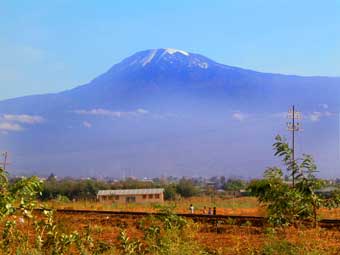 Surprise! The Kilimanjaro
and its summit surrounded with clouds can be seen very well from
the hotel. The mountain and its impressive size are majestic.
You would say that it belongs to another world.
Surprise! The Kilimanjaro
and its summit surrounded with clouds can be seen very well from
the hotel. The mountain and its impressive size are majestic.
You would say that it belongs to another world.
At 5.00 pm, briefing in the hotels garden, numerous instructions
which will be useful during the ascent! We are encouraged to
keep a clear mind to arrive not only at Gilman's Point but also
to reach the summit Uhuru Peak (=freedom peak). We are also told
not to get influenced by other people discouraging discourses
when they come back from the summit.
3rd day: Marangu Gate to Mandara Hut (2700m)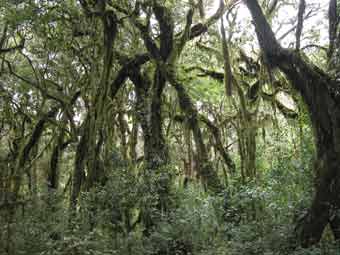
Greg, an Australian guy will make the ascent with us, our group
will be composed of a guide and a cook followed by their respective
assistants and nine carriers.
A minibus takes us to Marangu Gate (1800m), the most used and
easiest way. We quickly notice that other people get the same
idea as we did. The day is spent in the tropical forest where
lianas, giant ferns and all kind strange plants bow above our
heads. From time to time we get frightened by some baboons or
colobus monkeys. After 5 hours without difficulties we reach
Mandara Hut (2300m).
4th day: Mandara Hut to Horombo (3720m / 12,400 feet).
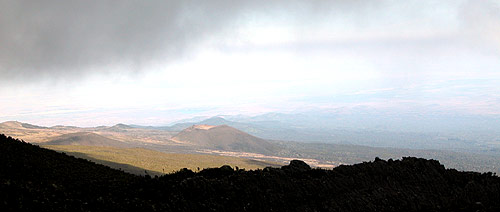
Nice day, it is hot and there is a lot of dust. The landscape
is magnificent and we have a nice view point on the African Plain.
The vegetation becomes rare. We go from the forest to a flourished
area. The lack of oxygen due to the altitude is now felt by everyone
and we slow down. It is an occasion to appreciate the panorama
which stretches out as far as the Kenyan frontiers.
Once we had arrived at Horombo Hut, a dark cloud came lowering
the temperature and the traditional tea which had just been made
by the assistant was very welcome.
5th day: acclimatization day
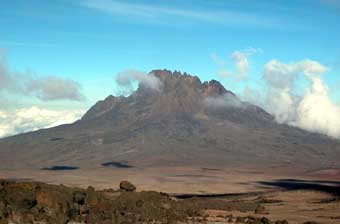 JI had a bad night.
I was envious of Bernard and Greg who slept like logs. The guide
offers to climb the Mawenzi, so we can become acclimatized. I
have a little headache, is it a sign of the mountain sickness?
Obsessed by this sought I take some more "coca 9CH",
a homeopathic replacement for the allopathic Diamox. We left
with the guide assistant. The path is steep, the vegetation becomes
even rarer and the landscape almost only made of stone. After
three hours walking, we reach Mawenzi Hut and there, take a one
hour break to eat some müsli bars and dried fruits. Then
we get back to the Horombo camp to spend the night there. My
headache had disappeared. We cannot wait for tomorrow, we are
impatient to climb the Kibo (4700m) which is the last step before
the final assault.
JI had a bad night.
I was envious of Bernard and Greg who slept like logs. The guide
offers to climb the Mawenzi, so we can become acclimatized. I
have a little headache, is it a sign of the mountain sickness?
Obsessed by this sought I take some more "coca 9CH",
a homeopathic replacement for the allopathic Diamox. We left
with the guide assistant. The path is steep, the vegetation becomes
even rarer and the landscape almost only made of stone. After
three hours walking, we reach Mawenzi Hut and there, take a one
hour break to eat some müsli bars and dried fruits. Then
we get back to the Horombo camp to spend the night there. My
headache had disappeared. We cannot wait for tomorrow, we are
impatient to climb the Kibo (4700m) which is the last step before
the final assault.
6th day: from Horombo to Kibo (4720m
/ 15,520 feet)
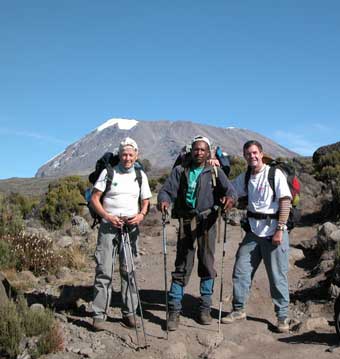 IIt is cold in the
hut, the water in my bottle was frozen this morning. We feel
good in our sleeping bags. Mine kept warm until -15°C but
Bernard's one, which was supposed to keep warm until -25°C,
was actually -2.5°C (he forgot his glasses the day he bought
it!).
IIt is cold in the
hut, the water in my bottle was frozen this morning. We feel
good in our sleeping bags. Mine kept warm until -15°C but
Bernard's one, which was supposed to keep warm until -25°C,
was actually -2.5°C (he forgot his glasses the day he bought
it!).
Departure from Kibo, the air is cold, we put on our warm clothes
and our carriers take some water because there are no more waterpoints
from now on.
We go through a strange landscape, stony and savage as if we
were on the moon, with a nice sight on the Mawenzi which we climbed
the day before. The altitude becomes more and more difficult
to stand for Greg who staggers and finally vomits. But as proud
and courageous as an Australian could be he goes on his way keeping
a nice smile on his face. After 7 hours walking we reach the
Kibo. Greg did not recover and goes to bed while Bernard and
I are relaxing, enjoying the last rays of sun before they disappear
behind the summit of the Kilimanjaro.
.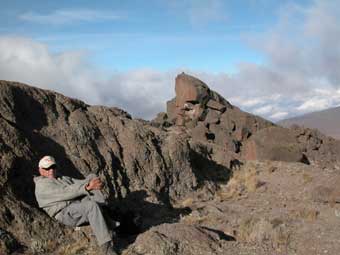
Night from the 6th to the 7th day
The fun is over now, we wake up at 11pm (no need to try to get
asleep, the altitude, the cold and the apprehension keep you
awake). After a little tea and some biscuits, we get ready for
the ascent. We will leave at 11:30pm. Outside it is -10?C. It
is pitch dark, we put on some headlamps and leave the camp. Though
we are totally conscious that the ascent will not be a piece
of cake: Gillmann's point is at 6 hours walk. We zigzag slowly
along the mountain. Elias, out guide is first, Bernard, Greg
and I follow 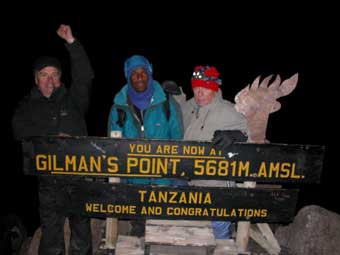 him,
and Steward, the guide assistant bring up the rear.
him,
and Steward, the guide assistant bring up the rear.
The ascent becomes a nightmare for Greg, at 5200m he vomits and
has to give up. Steward takes charge of him and we go on with
Elias. The more the path becomes steep, the more the cinder layer
becomes thick. We now really lack of oxygen and we breath heavily,
which make the ascent even harder. We pause more and more frequently,
but no more than 2 minutes, otherwise we could not go further.
The battery of my headlamp becomes weaker so I base my landmarks
on Bernard's legs which remind me of the way robots march. It
has been six hours now we walk silently, thousands of thoughts
are running through my head. 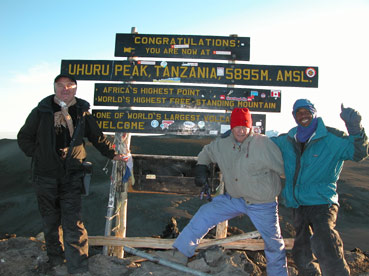 The
most frequent one is "when will I wake un from this nightmare?".
But suddenly, I hear Elias' voice "we have arrived at Gillman's
Point".
The
most frequent one is "when will I wake un from this nightmare?".
But suddenly, I hear Elias' voice "we have arrived at Gillman's
Point".
It is still dark but we are surrounded with happiness, we congratulate
each other. But we have not reached the summit of the Kilimanjaro
yet.
The summit of the volcano, Uhuru Peak at 5895m (19,340 feet)
is only at one hour and a half away. The path around the volcano
is less steep, therefore easier. It is during this last step
that the night progressively fades away. Under these equatorial
latitudes, auroras are relatively short. the sun quickly floods
the whiteness of the glaciers and all the top of Kilimanjaro.
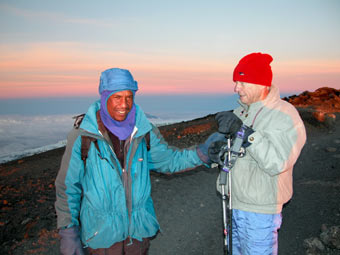 The emotion invades
me, I have tears in the eyes and at this moment, I understand
what feel the mountaineers, these conquerors of the useless:
happiness to have triumphed over the mountain and over themselves.
The emotion invades
me, I have tears in the eyes and at this moment, I understand
what feel the mountaineers, these conquerors of the useless:
happiness to have triumphed over the mountain and over themselves.
Now I know that I will reach the top of Africa. Elias congratulates
us for the feat. I share the joy to be victorious with Bernard,
I owe him our success because I would never have tried this climb
without him.
And now you think it is over? Not at all! We still had to go
down and to walk in one day what we had done in the two days
and one night. After 12 hours walking we spent the night at Horombo
hut.
7th day: down to Horombo hut
We have reached Horombo, we are tired, but happy and relieved.
The stress we were under these last few days has gone. We meet
Greg who is exhausted and sick: he tells us he reached Gilman's
Point with the guide assistant. What a lesson of courage! But
was it really reasonable, knowing the risks?
8th day: down to Marangu Gate.
Drinking a good Kilimanjaro beer (the local beer) in the hotel's
garden is one of the greatest pleasures of the days. We also
meet people who are going to climb, fresh and not aware of what
they will go through! Before we leave, we pay the guide and the
carriers. I give them some of the clothes I used during the ascent.
Everyone is satisfied.
Réflexion
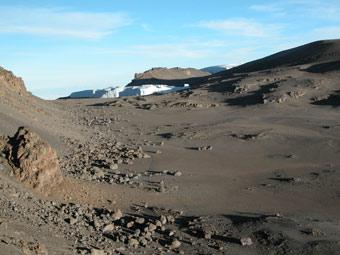 Kilimanjaro, snow
and glaciers on the equator, a geological curiosity, but for
how long?
Kilimanjaro, snow
and glaciers on the equator, a geological curiosity, but for
how long?
Because of the climate, which is brutally changing, and even
more on the equator, the glaciers and the snows are going to
disappear in the next 10 to 20 years, if we believe the specialists.
It will have important impacts on the ecosystem.
A large population is nowadays concentrating around the foot
of the Kilimanjaro because the region is fertile and irrigated
by the water coming down the glaciers: there is rice, 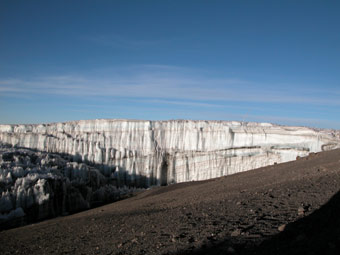 coffee,
cocoa beans. What will happen to this population?
coffee,
cocoa beans. What will happen to this population?
The decreasing snow cap and glacier will obviously reduce the
number of tourists.
The eternal snows of the Kilimanjaro celebrated by Hemingway
will become nothing else than eternal regret…